Last Fall at Joliet’s Gallery 7, USF Art & Design alum and Joliet, Illinois native, Roger Carlson produced the comprehensive and thoughtful exhibition, Innocent Dawn. The exhibit consisted of a number of artworks he has been diligently working upon since 2006. In early January, The COMP Magazine caught up with Carlson to discuss his recent exhibit, the ongoing challenges in maintaining a productive art practice, what he values in this process, and his goals for the New Year.
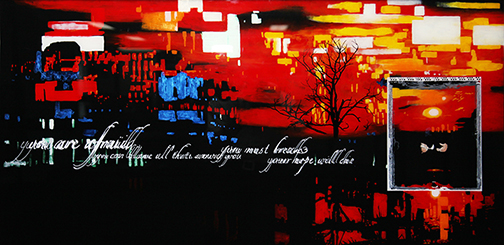
Roger Carlson, Scarlet Sunset Skies, 2015
Lets begin with an introduction to your recent solo exhibition at Gallery 7. You’ve been developing a series of work for some time. Can you offer an overview on the intent of the exhibition?
I started painting in reverse on Plexiglas in the spring of 2006. I wanted to paint on a different surface other than canvas. Plexiglas, for me, was the best choice because it gave me the opportunity to represent my two dimensional work in a completely different way. My paintings are reverse painted on the back of Plexiglas. Meaning, I first put down the last of the detail & then work my way to the background. Also, I have to paint everything backwards so it can be seen on the other side in the correct way. When artists paint on canvas, they may paint in areas of colors and roughly sketch in forms, and refine those forms as they go. I paint in reverse. I also don’t blend my colors together while I paint. I paint in layers. For example, I will put a color down and spread it out where it has feathered edges then paint the next color over. To achieve a blended look, I have to leave some of my brushstrokes transparent so the next color can be seen.
I start my paintings by designing them in Photoshop & Illustrator. I’ll use Illustrator for all of my text. After I am happy with the composition, I flatten the image in Photoshop, reverse the image, and print it out backwards to size. For example, if the painting is 24” x 48”, I’ll put guide lines 8“ across and 10” down. Then I’ll select an 8” x 10” area and just print that section. Then move my selection box over and print the next and so on. After I have everything printed, I’ll tape everything together until its full size. I then place the Plexiglas on top of the print, and i am ready to paint.
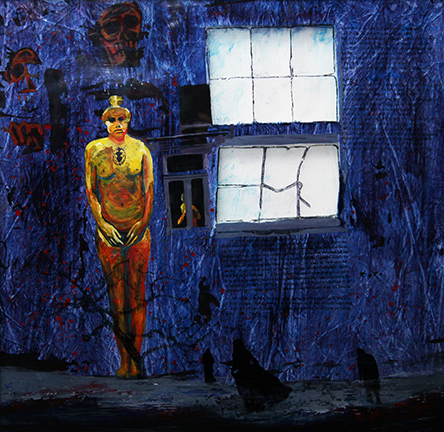
Roger Carlson, Disconnected, 2015
Can you share with us some of the challenges in maintaining a serious art practice?
Time is a challenge. We all have to work full time, and after coming home from work (especially if you have a long drive), The last thing you want to do is get back to work. Sometimes you have to do a little at a time like a half hour or so. And on the weekends do a little bit more. It all ads up.
Money is another challenge. If your an artist, you know how expensive art supplies are. (Just go to Michaels and see how much a 2oz tube of cadmium red acrylic costs!) In creating a painting or any other work of art, your going to spend money on art supplies and other material. It costs me about $50 to $250 or so, per painting, For the cost of acrylic paint, spray paint, ink, clear coat, Plexiglas, and frames. And that does not include design time, preparation (mixing colors, stretching & gessoing canvas, and in my case printing & taping the image to size.) And most importantly, the concept or idea of the piece.
Selling is a problem too. Most people don’t care about art or want to pay for it. Let’s face it, the only people that care about art are other artists, and people that can afford to buy it. And the people that can afford it, sometimes don’t want to pay what it is worth. As long as your reasonable with your prices don’t feel guilty asking a fair price for yourself. You have a handmade one of a kind piece. Don’t give it away. For me, my goal is to keep my paintings and continue to approach galleries for shows. If I sell one, I sell one. But I am going to get what I want for it.
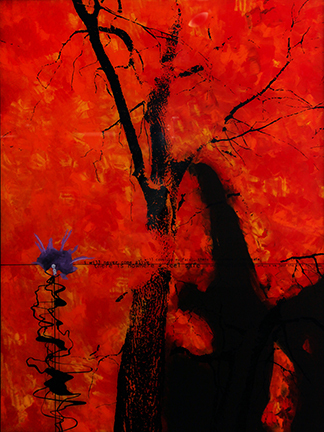
Roger Carlson, The Burning Tree, 2015
Ideas/concepts, when you don’t have them, you can’t work on anything. You want quality in your work. There’s no point in doing work unless it’s good enough for a gallery. You can’t just start a painting and work your way through it and building it up without a foundation (concept/idea). If you do that, you will create bad art and waste a lot of good material. For example, you can’t design A magazine cover without your target audience, text, photos, or design elements like line, color, or shape.
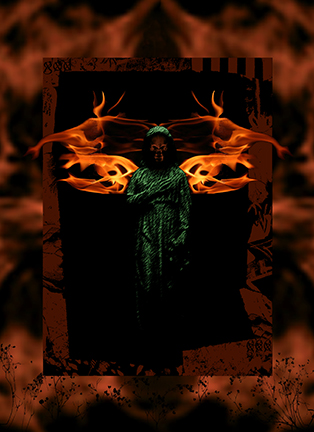
Roger Carlson, Internal = Eternal, 2015
What do you value in the art making process?
As an artist, I create a visual idea that is deep, personal, and real. It’s like I can capture a dreamlike (or nightmarish) moment that the viewer can relate to and have a strong and real reaction with. It’s a way I can connect with other people in a deep and personal level, in the same way a musician can connect with a listener.
I also like the handmade, one of a kind quality there is with art. You may see reproductions in posters or in books, but it is not the same. To see the real thing, makes a personal connection with you and the artist who created it. At times, it is awe inspiring. To stand three feet from an original, Dali, Picasso, or Warhol, just you and the artwork, you as an artist feel that you are part of something. That your art and ideas matter, because your doing as they did, using paint or other media, to create a visual idea.
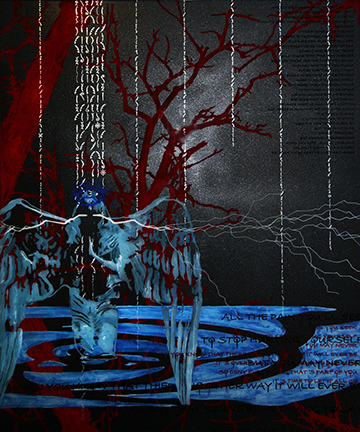
Roger Carlson, The Past Remains, 2015
Can you identify any specific philosophies or ideas that continue to surface in your aesthetic investigations?
I try to create my work timeless in content. In my paintings, I use my own images, and words and try to create visually, an understanding of what it is to be human in relationship to what is up coming in the wake of our death. I believe in an after life. I believe what we do, how we feel, what we believe, and how we evolve during our lifetime, determines how we will spend eternity. I believe the afterlife is the true reality, and we are limited as beings to what we can understand and do while we are human.
Although timeless in content, my work is very modern. I use computers to create my compositions. I also use text in my work, paint on a sheet of plastic, and frame my work in metal sectional frames. My content and my technique, although not completely original, have a certain level of innovation. That is very important to me because being more innovative means that my work is of a higher level of sophistication and quality.
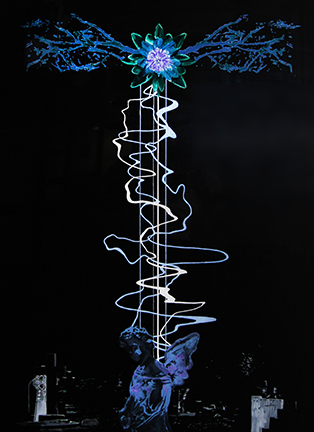
Roger Carlson, A New Reality, 2015
Is there a specific artwork or series that you see defining your ongoing investigations?
Fine art, design, and music inspire me to do what I do. I will go to gallery openings/art shows and be influenced by what I am drawn to. I really can’t point out any specific artist or artists that directly inspires my artwork. I can tell you that I love graffiti art like Ron English and Shepherd Ferry. At SOFA, I love the art of Rick Allen, Nathan Bennett, Cassandra Blackamoor, and Bruce McDonald. There work is completely different than mine, but I am absolutely influenced by it.
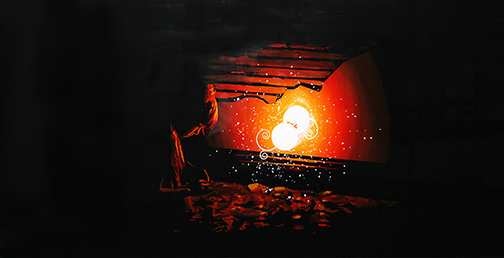
Roger Carlson, Innocent Dawn, 2015
What are you currently working upon? Do you have any projects or exhibitions scheduled for 2016?
Music Influences my artwork (content & composition) just as much fine art & design. Every time I work on a painting, I listen to music. I am a real music fan. I am willing to listen to an album three times or more all the way through just in order to “get it”. My favorite album, Loveless by My Bloody Valentine, the first time I listened to it, I had no idea what it was about. I liked the sound, but did not understand it. The second time I listened I remembered a little more and liked it more. The third time I listened to it, it all came together and it blew my mind. It was one of the best musical experiences for me. For example, The lyrics an music of Smashing Pumpkins, Tool, Faith No More, M83, Shiny Toy Guns, Groove Armada, Boards of Canada, and tons of others (way too many to list) directly influence what I do. I can’t create art without it.
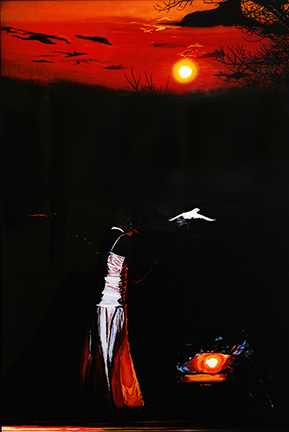
Roger Carlson, The Fall, 2015
I will continuing the reverse paintings on Plexiglas series in reason that I want a collection of paintings that I can have gallery shows with. As an artist I strive to be part of the art scene here in Chicago. I go to galleries, major art exopsitions like Expo Chicago and SOFA, and museums. I want to stay active and current as an artist, so it is important to me to attend openings and shows. You can’t grow as an artist without viewing as much art as possible in person. My work can be seen on Instagram, evil olive design.

Roger Carlson, Trinity, 2015
Additional information on the work of Roger Carlson, please visit:
Chicago Tribune: http://www.chicagotribune.com/suburbs/joliet-romeoville/community/chi-ugc-article-joliets-gallery-seven-to-present-innocent-2015-11-03-story.html
JJC News Room – http://news.jjc.edu/2012/02/jjc-hosts-innocent-dawn-by-former-student-roger-carlson-feb-27-march-23/
Chicago Gallery News – http://www.chicagogallerynews.com/calendar/roger-carlson-innocent-dawn
Interview by Chester Alamo-Costello


